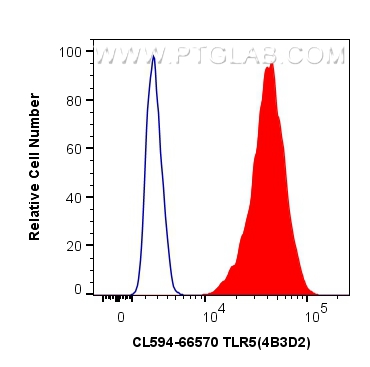验证数据展示
经过测试的应用
| Positive FC (Intra) detected in | THP-1 cells |
推荐稀释比
| 应用 | 推荐稀释比 |
|---|---|
| Flow Cytometry (FC) (INTRA) | FC (INTRA) : 0.80 ug per 10^6 cells in a 100 µl suspension |
| It is recommended that this reagent should be titrated in each testing system to obtain optimal results. | |
| Sample-dependent, Check data in validation data gallery. | |
产品信息
CL594-66570 targets TLR5 in FC (Intra) applications and shows reactivity with human, mouse, rat, pig samples.
| 经测试应用 | FC (Intra) Application Description |
| 经测试反应性 | human, mouse, rat, pig |
| 免疫原 |
CatNo: Ag13840 Product name: Recombinant human TLR5 protein Source: e coli.-derived, PGEX-4T Tag: GST Domain: 661-858 aa of BC109119 Sequence: TKFRGFCFICYKTAQRLVFKDHPQGTEPDMYKYDAYLCFSSKDFTWVQNALLKHLDTQYSDQNRFNLCFEERDFVPGENRIANIQDAIWNSRKIVCLVSRHFLRDGWCLEAFSYAQGRCLSDLNSALIMVVVGSLSQYQLMKHQSIRGFVQKQQYLRWPEDLQDVGWFLHKLSQQILKKEKEKKKDNNIPLQTVATIS 种属同源性预测 |
| 宿主/亚型 | Mouse / IgG1 |
| 抗体类别 | Monoclonal |
| 产品类型 | Antibody |
| 全称 | toll-like receptor 5 |
| 别名 | SLEB1, TIL3, toll like receptor 5, Toll/interleukin-1 receptor-like protein 3, Toll-like receptor 5 |
| 计算分子量 | 858 aa, 98 kDa |
| 观测分子量 | 100 kDa |
| GenBank蛋白编号 | BC109119 |
| 基因名称 | TLR5 |
| Gene ID (NCBI) | 7100 |
| RRID | AB_3084715 |
| 偶联类型 | CoraLite®594 Fluorescent Dye |
| 最大激发/发射波长 | 588 nm / 604 nm |
| 形式 | Liquid |
| 纯化方式 | Protein G purification |
| UNIPROT ID | O60602 |
| 储存缓冲液 | PBS with 50% glycerol, 0.05% Proclin300, 0.5% BSA, pH 7.3. |
| 储存条件 | Store at -20°C. Avoid exposure to light. Stable for one year after shipment. Aliquoting is unnecessary for -20oC storage. |
背景介绍
TLR5 belongs to the Toll-like receptor family which are important in the innate immune response to pathogens. TLRs are highly conserved from Drosophila to humans and share structural and functional similarities. TLR5 is known to recognize bacterial flagellin from invading mobile bacteria. TLR5 acts via MYD88 and TRAF6, leading to NF-kappa-B activation, cytokine secretion and the inflammatory response. Mutations in TLR5 gene have been associated with both resistance and susceptibility to systemic lupus erythematosus, and susceptibility to Legionnaire disease.
实验方案
| Product Specific Protocols | |
|---|---|
| FC protocol for CL594 TLR5 antibody CL594-66570 | Download protocol |
| Standard Protocols | |
|---|---|
| Click here to view our Standard Protocols |


